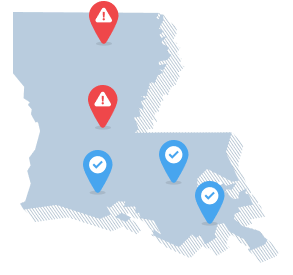The Safest and Most Dangerous Cities in Louisiana

Louisiana Security Solutions
The following is a list of cities that provide home security solutions in the state of Louisiana
Known for Bourbon Street, bayous, and some of the best cuisine in the world, Louisiana is a culturally diverse state with a colorful origin story. Initially claimed by France in 1682, the territory that would go on to become the Pelican State came under Spanish rule for a time. Then, it returned to French rule before being sold to the U.S. as part of the historic Louisiana Purchase in 1803.
Today, Louisiana’s identity is an amalgamation of Cajun, Creole, African, Native American, and European influences — all of which have shaped its one-of-a-kind music, food, language, and traditions. It’s the birthplace of jazz, the home of more than 3 million acres of wetlands, and the only state in the country to use ‘parishes’ instead of ‘counties’ to subdivide its geography.
Despite the state’s rich character, crime is one of its stumbling blocks. Louisiana ranks fourth in the nation for property crime and fifth for violent crime. Challenges with poverty, drugs, insufficient law enforcement resources, and other issues exacerbate the state’s crime troubles. But, we’ll dive deeper into those a little later on. First, let’s take a look at which Louisiana cities have the highest and lowest crime rates.
Louisiana cities with the highest and lowest crime rates
(per 100,000 people)
| Cities with the highest property crime rates | |
|---|---|
| Alexandria | 6,394 |
| Monroe | 6,048 |
| West Monroe | 5,895 |
| Cities with the highest violent crime rates | |
|---|---|
| Marksville | 2,209 |
| Monroe | 2,104 |
| Alexandria | 1,972 |
| Cities with the lowest property crime rates | |
|---|---|
| Basile | 84 |
| Jean Lafitte | 113 |
| Lake Arthur | 116 |
| Cities with the lowest violent crime rates | |
|---|---|
| Addis | 26 |
| Rayne | 43 |
| Golden Meadow | 60 |
Note: Excluding cities with crime rates of zero. Source: 2023 FBI Data
Louisiana Cities With the Highest Crime Rate
We begin with Alexandria, which is one of the most dangerous places in the state. The central Louisiana city of about 43,000 people ranks in the state’s top three for both violent crime and property crime. For property crime, it’s number one, with 6,394 incidents per 100,000 people. For violent crime, Alexandria comes in third, with 1,972 incidents per 100,000 residents. It’s common for victims of crime in Alexandria to know their attacker; in 2023, the city saw 18 homicides, and a third of them were domestic incidents.1
Another city that makes a repeat appearance in the property crime and violent crime rankings is Monroe. The northern Louisiana city, which is the ninth-largest in the state, had 2,104 violent incidents for every 100,000 residents in a year. This figure puts it in the number two spot for the category of violent crime. Monroe is also number two in the state for property crime, with 6,048 incidents per capita annually (its immediate neighbor, West Monroe, comes in at number three for property crime).
So, which Louisiana city has the most violent crime per capita? That title goes to Marksville, a town about 30 miles southeast of Alexandria. In 2023, the town had about 100 aggravated assaults — a comparatively large number for its population of under 5,000 people. Poor economic conditions are a big driver of crime here. The median income in Avoyelles Parish, which Marksville is part of, is $39,439.2 That’s about 50 percent less than the national median income of $77,719.3
Louisiana Cities With the Lowest Crime Rate
It’s not all bad news when it comes to crime in Louisiana. There are many communities that are incredibly safe, like Addis, which has the state’s lowest rate of violent crime. This Mississippi River town is right outside Baton Rouge, and, in 2023, there was just one robbery and one aggravated assault there.
The second-safest city in Louisiana for violent crime is Rayne, which also happens to be known as the “Frog Capital of the World.” The nickname originated back in the 1800s when merchants in the southern Louisiana city would ship frog legs back to France to be eaten as a delicacy.4 Today, frogs — not just their legs — are a big part of Rayne’s culture. The city even hosts an annual frog festival. Amphibian attractions aside, Rayne’s low per-capita violent crime rate of 43 makes it an appealing place to live.
Turning our focus to property crime, it doesn’t get much safer than Basile. The south-central Louisiana town is tiny by anyone’s standards, barely covering more than one square mile. The closest big city is Lafayette, which is about an hour away by car. In 2023, Basile’s only reported property crime was a single theft.
Heading southeast will take you to Jean Lafitte, a small town on the bayou outside of New Orleans. It’s home to airboat tours and the historic Filipino settlement of Manila Village (Filipinos were among the early pioneers of the state’s burgeoning seafood industry). Two thefts were Jean Lafitte’s only property crimes in 2023.
How Safe Is Louisiana Compared to Other States?
There’s so much to love about Louisiana — the state that gave us Louis Armstrong and jambalaya — which makes this next part hard to share: When you compare Louisiana crime to the rest of the country, the numbers aren’t great.
Here’s how the state stacks up in some of the major crime categories:
Property crime rates
(Per 100,000 residents)
| Category | Louisiana | National |
|---|---|---|
| Burglary | 447.0 | 250.7 |
| Larceny | 1805.8 | 1343.9 |
| Vehicle theft | 377.4 | 317.2 |
- Burglary: 78 percent above the national average
- Theft: 34 percent above the national average
- Vehicle theft: 18 percent above the national average
Violent crime rates
(Per 100,000 residents)
| Category | Louisiana | National |
|---|---|---|
| Murder/Non-negligent homicide | 14.5 | 5.7 |
| Aggravated assault | 433.1 | 263.7 |
| Robbery | 53.3 | 65.4 |
| Rape | 47.2 | 38.0 |
- Murder: 154 percent above the national average
- Aggravated assault: 64 percent above the national average
- Rape: 24 percent above the national average
Why is there so much crime in Louisiana? The state’s crime problem is complex, fueled by a combination of socioeconomic factors.
Poverty is a big one. Nineteen percent of people in the state live in poverty, compared to 11 percent nationwide. Gangs and drugs are also a problem. In East Baton Rouge Parish, which is the most populated parish in the state, an estimated 80 percent of violent crime can be attributed to drug dealers or gang members.5
Louisiana also has a long history of education challenges and underfunded public services, both of which contribute to higher crime.6 A 2024 report found that three-quarters of Louisiana school districts are chronically underfunded.7 That same year, the governor declared a state of emergency due to a police officer shortage that increased response times and put public safety at risk.8
Together, these factors create an environment where crime has remained high. Despite this, the state has made strides toward reducing criminal activity in recent years. In 2024, Louisiana implemented sweeping new laws designed to address its persistent crime troubles, including measures to lengthen sentences for certain offenses and limit access to parole.9 These changes seem to be making an impact; year-over-year, violent crime in Louisiana has declined by almost 13 percent. In that same time frame, property crime dropped by four percent.
Its lively culture, friendly people, and vibrant heritage make Louisiana an attractive and exciting place to call home — despite its elevated crime rates. If you’re interested in living there, cultivating an awareness of the cities with the highest and lowest crime levels and thoroughly researching neighborhoods can help you avoid becoming a victim.
Navigate Crime Data by State
- Alabama
- Alaska
- Arizona
- Arkansas
- California
- Colorado
- Connecticut
- Delaware
- Florida
- Georgia
- Hawaii
- Idaho
- Illinois
- Indiana
- Iowa
- Kansas
- Kentucky
- Maine
- Maryland
- Massachusetts
- Michigan
- Minnesota
- Mississippi
- Missouri
- Montana
- Nebraska
- Nevada
- New Hampshire
- New Jersey
- New Mexico
- New York
- North Carolina
- North Dakota
- Ohio
- Oklahoma
- Oregon
- Pennsylvania
- Rhode Island
- South Carolina
- South Dakota
- Tennessee
- Texas
- Utah
- Vermont
- Virginia
- Washington
- West Virginia
- Wisconsin
- Wyoming
Where Our Crime Data Comes From
Unless specified otherwise, the information in this article is based on crime data compiled by the FBI and made available through the Crime Data Explorer. Statewide violent and property crime statistics are drawn from the FBI’s 2023 Crime in the United States Report (Table 5), while metro area data comes from Table 6, which breaks down offenses by metropolitan statistical areas. For city-level crime rates, we referred to Table 8, which lists reported offenses by state and city.
Important Note: Crime statistics offer valuable insights, but they aren’t the only way to evaluate a community’s safety. Local context, law enforcement practices, and reporting standards can all influence how crime is recorded. Additionally, FBI publication tables and the data displayed on the Crime Data Explorer may differ slightly due to variations in methodology.
Citations
- KALB. (2024, Sept 27). Homicides in Alexandria.
https://www.kalb.com/2024/09/27/homicides-alexandria/ - U.S. Census Bureau. (2024). QuickFacts: United States; Avoyelles Parish, Louisiana.
https://www.census.gov/quickfacts/fact/table/US,avoyellesparishlouisiana/PST045223 - U.S. Census Bureau. (2024). American Community Survey | Selected Economic Characteristics.
https://data.census.gov/table/ACSDP1Y2023.DP03 - FOX8. (2017, May 2). Heart of Louisiana: Frog Capital of the World.
https://www.fox8live.com/story/35324756/heart-of-louisiana-frog-capital-of-the-world/ - WAFB. (2024, Apr 11). EBRSO announces new unit targeting gangs, groups.
https://www.wafb.com/2024/04/11/ebrso-announces-new-unit-targeting-gangs-groups/ - United Teachers of New Orleans. (2024). Why is Louisiana ranked so low in education?
https://utno.la.aft.org/news/why-louisiana-ranked-so-low-education - Public News Service. (2024, Jan 25). LA schools among the nation’s most chronically underfunded.
https://www.publicnewsservice.org/2024-01-25/education/la-schools-among-the-nations-most-chronically-underfunded/a88459-1 - Louisiana.gov. (2024, Feb 16). Governor Landry Issues Executive Order: Declares State of Emergency Due to Officer Shortage in Louisiana.
https://gov.louisiana.gov/index.cfm/newsroom/detail/4423 - The New York Times. (2024, Mar 6). With Sweeping New Laws, Louisiana Embraces Tough-on-Crime Approach.
https://www.nytimes.com/2024/03/06/us/louisiana-laws-crime.html
